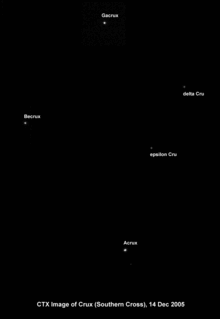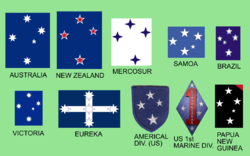- Crux
-
"Southern Cross" redirects here. For other uses, see Southern Cross (disambiguation).For other uses, see Crux (disambiguation).
Crux Constellation 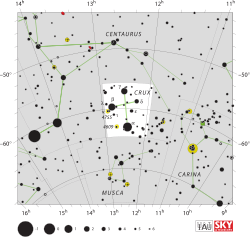
List of stars in CruxAbbreviation Cru Genitive Crucis Pronunciation /ˈkrʌks/, genitive /ˈkruːsɨs/ Symbolism the Southern Cross Right ascension 12.5 h Declination −60° Quadrant SQ3 Area 68 sq. deg. (88th) Main stars 4 Bayer/Flamsteed
stars19 Stars with planets 1 Stars brighter than 3.00m 5 Stars within 10.00 pc (32.62 ly) 0 Brightest star Acrux (α Cru) (0.87m) Nearest star η Cru
(64.22 ly, 19.69 pc)Messier objects 0 Meteor showers Crucids Bordering
constellationsCentaurus
MuscaVisible at latitudes between +20° and −90°.
Best visible at 21:00 (9 p.m.) during the month of May.Crux is the smallest of the 88 modern constellations, but is one of the most distinctive. Its name is Latin for cross, and it is dominated by a cross-shaped asterism that is commonly known as the Southern Cross.
Contents
Visibility
Crux is easily visible from the southern hemisphere at practically any time of year. It is also visible near the horizon from tropical latitudes of the northern hemisphere for a few hours every night during the northern winter and spring. For instance, it is visible from Cancun or any other place at latitude 25° N or less at around 10 pm at the end of April.[1][2]
Location and identification
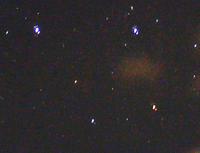 The five brightest stars in Crux are clearly visible in this picture. The red giant Gacrux and orange giant Epsilon are distinctly different from the three other major stars of the constellation, which are blue-white in colour
The five brightest stars in Crux are clearly visible in this picture. The red giant Gacrux and orange giant Epsilon are distinctly different from the three other major stars of the constellation, which are blue-white in colour
Contrary to popular belief, Crux is not opposite to Ursa Major. In fact, in tropical regions both Crux (low in the south) and Ursa Major (low in the north) can be seen in the sky from April to June. Crux is exactly opposite to Cassiopeia on the celestial sphere, and therefore it cannot appear in the sky with the latter at the same time. For locations south of 34°S, Crux is circumpolar and thus always visible in the night sky.
Crux is bordered by the constellations Centaurus (which surrounds it on three sides) and Musca.
Crux is sometimes confused with the nearby False Cross by stargazers. Crux is somewhat kite-shaped, and it has a fifth star (ε Crucis). The False Cross is diamond-shaped, somewhat dimmer on average, does not have a fifth star and lacks the two prominent "Pointer Stars."
Notable features
Stars
Three of the five main Crux stars—Acrux, Mimosa, and Delta Crucis—are co-moving B-type members of the Scorpius-Centaurus Association, the nearest OB association to the Sun.[3] They are among the highest-mass stellar members of the Lower Centaurus-Crux subgroup of the association, with ages of roughly 10 to 20 million years.[4][5]
Markers
Since the southern sky lacks an easily visible pole star, Alpha and Gamma (known as Acrux and Gacrux respectively) are commonly used to mark south. Tracing a line from Gacrux to Acrux and extending it for approximately 4.5 times the distance between the 2 stars leads to a point close to the Southern Celestial Pole. Alternatively, if a line is constructed perpendicularly between Alpha Centauri and Beta Centauri, the point where the above mentioned line and this line intersect marks the Southern Celestial Pole. The two stars of Alpha and Beta Centauri are often referred to as the "Southern Pointers" or just "The Pointers", allowing people to easily find the asterism of the Southern Cross or the constellation of Crux.
Letters and names
- α is named Acrux, a concatenation of "Alpha" and "Crux" and named by American Elijah Burritt in the 19th Century.
- β is named Mimosa
- γ is named Gacrux, a portmanteau of "Gamma" and "Crux".
- δ is the fourth brightest star, but it has no designated name.
- ε is inside the cross.
Deep sky objects
The Coalsack Nebula is the most prominent dark nebula in the skies, easily visible to the naked eye as a big dark patch in the southern Milky Way.
The Open Cluster NGC 4755, better known as the Jewel Box or Kappa Crucis, was discovered by Nicolas Louis de Lacaille in 1751–1752. It lies at a distance of 1.9±0.3 kiloparsecs or 6,900 light years and consists of approximately 100 stars spread across an area of about 20 square light-years.
History
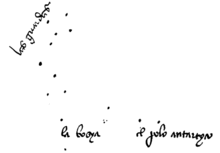 Depiction of the Crux (labelled 'Las Guardas') by physician-astronomer Mestre João Faras in his letter of May 1, 1500, to King Manuel I of Portugal from the newly discovered land of Brazil
Depiction of the Crux (labelled 'Las Guardas') by physician-astronomer Mestre João Faras in his letter of May 1, 1500, to King Manuel I of Portugal from the newly discovered land of Brazil
Crux was visible to the Ancient Greeks, who regarded it as part of the constellation Centaurus. However, the precession of the equinoxes gradually lowered its stars below the European horizon, and they were eventually forgotten by the inhabitants of northern latitudes. By AD 400, most of the constellation never rose above the horizon for Athenians.[citation needed]
The 15th century Venetian navigator Alvise Cadamosto made note of what was probably the Southern Cross on exiting the Gambia River in 1455, calling it the carro dell'ostro ("southern chariot"). However, Cadamosto's constellation had too many stars and was tilted incorrectly.[6] Historians generally credit João Faras - astronomer and physician of King Manuel I of Portugal who accompanied Pedro Álvares Cabral in the discovery of Brazil in 1500 - for being the first European to depict it correctly. Faras sketched and described the constellation (calling it "Las Guardas") in a letter written on the beaches of Brazil on May 1, 1500, to the Portuguese monarch.[7]
The separation of Crux from Centaurus is generally attributed to the French astronomer Augustin Royer in 1679. Other historians attribute the invention of Crux to Petrus Plancius in 1613, noting that the constellation was later published by Jakob Bartsch in 1624.[citation needed]
Cultural significance of the Southern Cross
The most prominent feature of Crux is the distinctive asterism known as the Southern Cross. It has great significance in the cultures of the southern hemisphere.
Flags and symbols
Main article: Southern Cross FlagBeginning in the colonial age, Crux became used as a national symbol by several southern nations. The brightest stars of Crux appear on the flags of Australia, Brazil, New Zealand, Papua New Guinea and Samoa. They also appear on the flags of the Australian state of Victoria, the Australian Capital Territory, the Northern Territory, as well as the flag of Magallanes Region of Chile, the flag of Londrina (Brazil) and several Argentine provincial flags and emblems (for example,, Tierra del Fuego and Santa Cruz). The flag of the Mercosur trading zone displays the four brightest stars. Crux also appears on the Brazilian coat of arms.
In Australia, the Southern Cross played a crucial role as symbol of the Eureka Stockade. In the Eureka Oath from Peter Lalor's famous speech in 1854 under the Eureka Flag he proclaimed "We swear by the Southern Cross to stand truly by each other and fight to defend our rights and liberties." TOf the Australian national flag, the Australian poet Banjo Paterson wrote in 1893,
"The English flag may flutter and wave,
where the world wide oceans toss,
but the flag the Australian dies to save,
is the flag of the Southern Cross.he Southern Cross was written into the lyrics of "Advance Australia Fair" in 1901: "Beneath our radiant Southern Cross"; the song was adopted as the Australian National Anthem in 1984. The victory song of the Australian national cricket team is entitled "Under the Southern Cross I Stand".
The Southern Cross was included in the lyrics of the Brazilian National Anthem (1909): "A imagem do Cruzeiro resplandece" ("the image of the Cross shines"). The five stars are also in the logo of the Brazilian football team Cruzeiro Esporte Clube and the Brazilian coat of arms; it is mentioned in the Brazlian national anthem, and even featured as the name of the currency (the cruzeiro from 1942 to 1986 and again from 1990 to 1994. The constellation is displayed in all coins of the current series of the Brazilian real.
A stylized version of Crux appears on the Australian Eureka Flag. The constellation was also used on the dark blue, shield-like patch worn by personnel of the U.S. Army's Americal Division, which was organized in the Southern Hemisphere, on the island of New Caledonia, and also the blue diamond of the U.S. 1st Marine Division, which fought on the Southern Hemisphere islands of Guadalcanal and New Britain.
In other astronomical systems
In Australian Aboriginal astronomy, Crux and the Coalsack mark the head of the 'Emu in the Sky' in several Aboriginal cultures, while Crux itself is said to be a possum sitting in a tree and a representation of the sky deity Mirrabooka.[citation needed]
In ancient Hindu astrology, the modern Crux is referred to as Trishanku.[8]
In Indonesia and Malaysia, it is known as Buruj Pari (the constellation of the Stingray).
The Javanese people of Indonesia called this constellation Gubug pèncèng ("raking hut") or lumbung ("the granary"), because the shape of the constellation was like a raking hut.[9]
The Māori name for the Southern Cross is Te Punga ("the anchor"). It is thought of as the anchor of Tama-rereti's waka (the Milky Way), while the Pointers are its rope.[citation needed]
In Mapudungun, the language of Patagonian Mapuches, the name of the Southern Cross is Melipal, which means "four stars". In Quechua, the language of the Inca civilization, Crux is known as "Chakana", which means literally "stair" (chaka, bridge, link; hanan, high, above), but carries a deep symbolism within Quechua mysticism.[10]
In Samoa the constellation is called Sumu ("triggerfish") because of its rhomboid shape, while α and Β Centauri are called Luatagata (Two Men), just as they are in Tonga.
In Tonga it is known as Toloa ("duck"); it is depicted as a duck flying south, with one of his wings (δ Crucis) wounded because Ongo tangata ("two men", [[α Centauri|α and Β Centauri) threw a stone at it. The Coalsack is known as Humu (the "triggerfish"), because of its shape.[11]
Among Tuaregs, the four most visible stars of Crux are considered iggaren, i.e. four Maerua crassifolia trees.[citation needed]
In popular culture
Argentine Gauchos are well known for using it for night orientation in the vast Pampas and Patagonic regions. It is also of cultural significance, as it is referenced in several songs and literature, including the Martin Fierro.
In the Victory At Sea suite, Richard Rodgers wrote "Beneath The Southern Cross" to depict the battleships in convoy and the lonliness of the sailors in the Southern Pacific during World War II. This tango melody is also "No Other Love Have I" in the musical "Me and Juliet" and a popular hit for Perry Como during the 1950s.
Cruzeiro Esporte Clube (Crux/Southern Cross Sports Club) is a first class football (soccer) club in Brazil.
The Nintendo game, StarTropics, for the NES features many references to and depictions of the Southern Cross.
The main character from the Namco game for the PlayStation Portable Ace Combat X: Skies of Deception who remains unnamed in the story but rather goes by his codename Gryphus-1 (as he is the leader of the Gryphus Squadron) is known as the "Southern Cross", and his squadron's emblem is an Andean Condor with the Southern Cross in its beak. Eugene Solano, his mission operator, is codenamed "Crux".
Melbourne's Southern Cross Hotel was built and named in 1962 and was one of the city's foremost hotels during the decade. The hotel was demolished in 2005 and replaced by the similarly named office building known as Southern Cross Tower.
There is a town in the Western Australian wheatbelt approx 300 km east of Perth called Southern Cross.
"The Sign of the Southern Cross" is a Song by Black Sabbath written in 1981 which was sung by Ronnie James Dio.
The Argentinian singer Charly Garcia says that he is from the southern cross in the song "No voy en tren".
"Southern Cross" is also a 1982 song by the classic rock group Crosby, Stills and Nash, written by Rick Curtis, Michael Curtis, and Stephen Stills. This song was also covered by Jimmy Buffett and is commonly played at his concerts.
Melbourne's Spencer Street Station was rebuilt and renamed "Southern Cross Station" in 2006.
The 1974 Australian America's Cup Challenger was named "Southern Cross" KA 4 representing the Royal Perth Yacht Club and was defeated 4-0 sailing off Newport Rhode Island by "Courageous" US26 sailing for the New York Yacht Club. Southern Cross became the trial horse for the 1977 Australian Challenger "Australia" KA 5 representing the Sun City Yacht Club that was defeated 4-0 sailing off Newport Rhode Island by Courageous US26 sailing for the New York Yacht Club.
The Argentine Air Force acrobatic display team is called Cruz del Sur, the Spanish for "Southern Cross".
The opening lines of South African composer Koos du Plessis' Christmas carol, 'Somerkersfees' (Summer Christmas) are:
- Welkom o stille nag van vrede (Welcome, o silent night of peace)
- Onder die suiderkruis (Beneath the Southern Cross)
There is a town called Suiderkruis (Southern Cross) in the Western Cape province of South Africa,
After identifying a need for a church for Afrikaans speakers living in Holland, a church was established in Leusden and is known as Suiderkruis Kerk. (Southern Cross Church)
The manga and anime series Fist of The North Star has one of its major fighting style, Nanto Seiken, with the Crux as its symbol.
The Commonwealth Bank of Australia uses a stylized image of the Southern Cross as a corporate logo.[citation needed]
Zeitgeist: the Movie claims that the Sun can be in the vicinity of Crux: this is not possible because Crux is not a zodiac constellation.[12][13]
"Southern Cross" is the Japanese title of the Orange Crew, a group of Gym Leaders who preside over the Orange Island archipelago's league and are featured in the Pokémon anime. Furthermore, the locations of the Orange League Gyms align with the positions of the main stars in the Crux constellation.
In a Knights of Zodiac movie, there is a Eris' ghost knight, represented by the Southern Cross.
The 1997 Rolf de Heer film, Epsilon, also known as Alien Visitor, an alien in female form descends to Earth from Epsilon in the Southern Cross, and inspires an Outback traveler to better his planet.
Patti Smith recorded a song called "Beneath The Southern Cross" on her 1996 album _Gone Again_.
Namesakes
USS Crux (AK-115) was a United States Navy Crater class cargo ship named after the constellation.
See also
References
- ^ Pasachoff, Jay M (2000). Field Guide to the Stars and Planets. Houghton Miflin. p. 67. ISBN 9780395934319.
- ^ "Ian Ridpath.com: Constellations". http://www.ianridpath.com/constellations1.htm. Retrieved March 4, 2011.
- ^ Preibisch, T., Mamajek, E. (2008). "The Nearest OB Association: Scorpius-Centaurus (Sco OB2)". Handbook of Star-Forming Regions 2: 0. arXiv:0809.0407. Bibcode 2008hsf2.book..235P.
- ^ de Geus, E. J., de Zeeuw, P. T., & Lub, J. (1989). "Physical Parameters of Stars in the Scorpio-Centaurus OB Association". Astronomy & Astrophysics 216 (3): 44–61. Bibcode 1989A&A...216...44D.
- ^ Mamajek, E.E., Meyer, M.R., & Liebert, J. (2002). "Post-T Tauri Stars in the Nearest OB Association". Astronomical Journal 124 (3): 1670–1694. arXiv:astro-ph/0205417. Bibcode 2002AJ....124.1670M. doi:10.1086/341952.
- ^ "We likewise observed...due south by compass, a constellation of six large bright stars, in the figure of a cross in this form...we conjectured this to be the southern chariot, but could not expect to observe the principal star, as we had not yet lost sight of the north pole." A. Cadamosto Navigatione, written c.1465 (1550 Ramusio edition, p.116r; 1811 Kerr edition p.244)
- ^ Revista do Instituto Histórico e Geográfico Brasileiro, Rio de Janeiro, 1843, tomo V nº 19. online
- ^ "Crux - Trishanku". Space Yuga. 10 Feb., 2010. http://spaceyuga.com/crux-constellation-hindu-mythological-name-trishanku/. Retrieved 15 June 2011.
- ^ Daldjoeni N. 1984. Pranatamangsa, the javanese agricultural calendar – Its bioclimatological and sociocultural function in developing rural life. The Environmentalist 4:15–18 DOI:10.1007/BF01907286.
- ^ Chakana: Inca Cross
- ^ Kik Velt; Stars over Tonga
- ^ "Constellation". Cosmos - The SAO Encyclopedia of Astronomy. Swinburne University. (Table of all constellations). http://astronomy.swin.edu.au/cosmos/C/Constellation.
- ^ "Zodiac". Cosmos - The SAO Encyclopedia of Astronomy. Swinburne University. http://astronomy.swin.edu.au/cosmos/Z/Zodiac.
External links
- Letter of Andrea Corsali 1516-1989: with additional material ("the first description and illustration of the Southern Cross, with speculations about Australia ...") digitised by the National Library of Australia.
- The Deep Photographic Guide to the Constellations: Crux.
- The Cambridge Guide to the Constellations, Michael E. Bakich, Cambridge University Press, 1995, pg. 85.
- Universe: The Definitive Visual Dictionary, Robert Dinwiddie and others., DK Adult Publishing, (2005), pg. 396.
- The Sign of the Southern Cross Black Sabbath
- Ian Ridpath and Wil Tirion (2007). Stars and Planets Guide, Collins, London. ISBN 978-0007251209. Princeton University Press, Princeton. ISBN 978-0691135564.
- Southern Cross Starry Night Photography.
- Star Tales – Crux
- Finding the South Pole in the sky
- Southern Cross in Te Ara – the Encyclopedia of New Zealand
- Tell time from the position of the southern cross http://puggle.byethost14.com/homepage/cruxstuff.html
Andromeda · Antlia · Apus · Aquarius · Aquila · Ara · Aries · Auriga · Boötes · Caelum · Camelopardalis · Cancer · Canes Venatici · Canis Major · Canis Minor · Capricornus · Carina · Cassiopeia · Centaurus · Cepheus · Cetus · Chamaeleon · Circinus · Columba · Coma Berenices · Corona Australis · Corona Borealis · Corvus · Crater · Crux · Cygnus · Delphinus · Dorado · Draco · Equuleus · Eridanus · Fornax · Gemini · Grus · Hercules · Horologium · Hydra · Hydrus · Indus · Lacerta · Leo · Leo Minor · Lepus · Libra · Lupus · Lynx · Lyra · Mensa · Microscopium · Monoceros · Musca · Norma · Octans · Ophiuchus · Orion · Pavo · Pegasus · Perseus · Phoenix · Pictor · Pisces · Piscis Austrinus · Puppis · Pyxis · Reticulum · Sagitta · Sagittarius · Scorpius · Sculptor · Scutum · Serpens · Sextans · Taurus · Telescopium · Triangulum · Triangulum Australe · Tucana · Ursa Major · Ursa Minor · Vela · Virgo · Volans · VulpeculaCategories:- Crux constellation
- Constellations
- National symbols
- Southern constellations
- Western constellations
Wikimedia Foundation. 2010.

